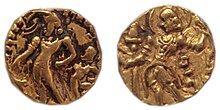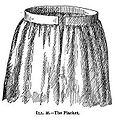Angarkha
The term angarkha, also called angrakha, refers to a traditional upper garment worn by men in the Indian Subcontinent which overlaps and is tied to the left or right shoulder. The angrakha was a court outfit that a person could wrap around himself, offering flexible ease with the knots and ties appropriate for wearing in the various principalities of ancient India. It is worn particularly in India, Nepal, Bangladesh and in Pakistan much like the Achkan and Sherwani.


Etymology
The term angarkha is derived from the Sanskrit word aṅgarakṣaka, which means protection of the body.[1] The angarkha was worn in various parts of the Indian Subcontinent, but while the basic cut remained the same, the style and length varied from region to region.[2]
Design
Some styles of the angarkha can be short. However, the angarkha can also be a long coat, or it can be a long tunic which is tied to either the left or right shoulder.[3] Sometimes, cotton jackets or tops are worn underneath the angarkha.[4]
Another style of angarkha is a sort of shirt worn under the jama and tied in two places on each side of the body. The angarkha also refers to a short calico vest with sleeves which descends only to the haunches. Instead of being fastened on both sides, is tied on one side only.[5]
Gujarati and Rajasthani styles
A similar dress to the kurta known as the angarkha is traditionally worn in Gujarat and Rajasthan[6] which is somewhat shorter in length than a straight cut Kurta and has a wider end similar to lower part of a ghagra.The front opens at either shoulder and the bottom has a wide end which flares out. Some styles incorporate a placket.
The Rajasthani angarkha falls just below the waist[7] in loose vertical gathers.[8]
In Gujarat, men in parts of Kutch wear the angarkha, also called the jama,[9] which has an asymmetric opening with the skirt flaring out to around the hips.[10] However, some styles fall to below the knees.
-
Man on the left in Gujarati jama/angarkha
Rajasthani bandia angarkha
Another type of angarkha worn in Rajasthan is the bandia angarkha, also known as bandi,[11][12] and angarkhi[13] worn above the waist and fastened with tapes either over the chest or on the shoulder, with long arms and narrow sleeves. The prints on the Rajasthani garments include sanganer prints which are of local origin.[14]
-
Bandhani, tie dyed dresses drying in Jaipur
Mirjai
The traditional dress of Bihari people is the mirjai which is a modified form of the flowing robe (known as the jama)[15] fastened on the right.[16][17] The mirjai is an under jacket with long loose sleeves and open cuffs.
Gujarati kediyu
The kediyu is worn in Gujarat. It is a long sleeved upper garment, pleated at the chest and reaching to the waist.[18][19] Some designs however flare out to the knees. The prints on the kediyu include bandhani designs which are local to Gujarat and Rajasthan.[20]
-
India (Gujarat), man's kediyu suruwal, Bunka Gakuen Costume Museum
-
Gujarati men in kediyu
-
Bandhani prints
-
Bandhani print, open
Punjabi angarkha
A garment worn by women in the Punjab region was the anga (gown also known as an angarkha[21][22] and peshwaj)[23] which is similar to a loose coat and wadded with cotton.[24] The women's anga flowed to the ankles. The angarkha also forms part of the male clothing in the Punjab region;[25] it is a loose tunic[26] that falls to below the knees,[27] is fastened with a flap to the side and is worn with a front opening kurta.[28] Men still wear the angarkha in Haryana which fastens to the left or right shoulder and Himachal Pradesh.
-
Ranjit Singh Equestrian in Saffron Robes
-
A watercolor portrait of Ranjit Singh who wore the angarkha during his reign[29]
Chamba angarkhi
The Chamba angarkhi of Himachal Pradesh is sewn tight at the torso, but below the waist it has an open fall like the modern skirt. The angarkhi is tied at the waist with a sash.[30]
Kalidar angarkha
In Uttarakhand, men traditionally wear the kalidar angarkha which has many panels.[31]
Elsewhere
A variation of the angarkha is worn in Uttarakhand,[32] Himachal Pradesh,[33] Maharashtra[34] and Bengal where the traditional male upper garment is the overlapping and string tied garment.[35]
-
Gujarati angarkha
-
Illustration of a placket, or opening used in an angarkha
Sindhi angerkho
The Sindhi angerkho is fastened to the left shoulder and is knee length. Modern versions can be shorter.
-
Man in Sindhi long angerkho top (1845)
Other related garments
Jhabbho
Another upper garment worn in Gujarat is the jhabbho which is a long robe.[36] The jhabho is also called the abho which is also worn by women of Rajasthan. The garment is loose, with short, wide sleeves, open at the neck, loose-fitting on the upper part and very flared at the skirt. The abho is often decorated in embroidery and mirror work.[37]
-
Wedding dress (abho), Memon or Jat, Banni, Kutch, Gujarat, India, late 19th to early 20th century, silk, glass mirrors
Saluka
A short sleeve cotton shirt, without a collar,[38] to the waist (called saluka[39] or ganji)[40] is traditionally worn in Uttar Pradesh.[41] The saluka is also traditionally worn in Madhya Pradesh.[42]
Sindhi cholo
The female Sindhi cholo[43][44] is loose fitting,[45] and is made in a variety of ways, including the traditional method of the cholo opening at the front to the waist,[46][47] with very wide sleeves.[48] The traditional cholo can reach down to the ankles.[49]
Images
-
Samudragupta depicted with angarkha, Gupta Empire
-
Sculpture depicted with angarkha, sash and outer coat, 1st century CE
-
Sculpture depicted with angarkha, sash and outer coat, 1st century CE
-
A man dressed in angarkha with dora or sash wrapped around the waist
See also
References
- ^ Zaira Mis, Marcel Mis (2001) Asian Costumes and Textiles: From the Bosphorus to Fujiama [1]
- ^ Kumar, Ritu (2006) Costumes and textiles of royal India[2]
- ^ Wilson, Horace Hayman (1855) A Glossary of Judicial and Revenue Terms: And of Useful Words Occurring in Official Documents Relating to the Administration of the Government of British India, from the Arabic, Persian, Hindustání, Sanskrit, Hindí, Bengálí, Uriya, Maráthi, Guazráthí, Telugu, Karnáta, Tamil, Malayálam, and Other Languages [3]
- ^ Census of India, 1961, Volume 8, Part 6, Issue 1 [4]
- ^ Carpenter, Horace W. (1866) The textile manufactures and the costumes of the people of India [5]
- ^ S. And Sahgal, Malik Gettingahead In Social Studies:, Book 3
- ^ Indian & Foreign Review, Volume 22 (1984)
- ^ Vijaya Ghose, Jaya Ramanathan, Renuka N. Khandekar (1992) Tirtha, the Treasury of Indian Expressions. [6]
- ^ Tierney, Tom (2013) Fashions from India
- ^ Sarosh Medhora (02.09.2000) The Tribune. Focus on men’s formals
- ^ Bhandari, Vandana (2005) Costume, textiles and jewellery of India: traditions in Rajasthan [7]
- ^ Ghurye, Govind Sadashiv (1966) Indian Costume
- ^ Rajasthan [district Gazetteers].: Baran (1997) [8]
- ^ Koṭhārī, Gulāba (1995) Colourful textiles of Rajasthan
- ^ Winer, Lise (2009) Dictionary of the English/Creole of Trinidad & Tobago: On Historical Principles [9]
- ^ O`malley, L.S.S. (1924) Bihar And Orissa Gazetteers Shahabad
- ^ The Eastern Anthropologist, Volumes 27-28 (1974)
- ^ Swaminarayan (2006) Vachanamrut
- ^ Simran Ahuja (2014) Nine Nights: Navratri
- ^ Murphy, Veronica and Crill, Rosemary (1991) Tie-dyed Textiles of India: Tradition and Trad [10]
- ^ Rajaram Narayan Saletore (1974) Sex Life Under Indian Rulers
- ^ Panjab University Research Bulletin: Arts, Volume 13, Issue 1 - Volume 14, Issue 1 (1982) [11]
- ^ B. N. Goswamy, Kalyan Krishna, Tarla P. Dundh (1993) Indian Costumes in the Collection of the Calico Museum of Textiles, Volume 5 [12]
- ^ Punjab District Gazetteers - District Attock Year Published 1930 BK-000211-0160 [13]
- ^ Kumar Suresh Singh, V. Bhalla, Swaran Singh (1997) Chandigarh [14]
- ^ Punjab District Gazetteers: Ibbetson series, 1883-1884]. [15]
- ^ Punjab gazetteers, 1883, bound in 10 vols., without title-leaves (1883) [16]
- ^ Punjab District Gazetteers Karnal 1919 [17]
- ^ Gupta, Hari Ram (1991) History of the Sikhs: The Sikh lion of Lahore, Maharaja Ranjit Singh, 1799-1839 [18]
- ^ Kamal Prashad Sharma, Surinder Mohan Sethi (1997) Costumes and Ornaments of Chamba[19]
- ^ Uttar Pradesh District Gazetteers: Uttarkashi 1979 [20]
- ^ Dehradun: International Traveller Archived July 15, 2015, at the Wayback Machine
- ^ Public Relations Department, Himachal Pradesh. Himachal Pradesh Cultural Heritage [21]
- ^ Mohanty, P.K (2006) Encyclopaedia of Scheduled Tribes in India: In Five Volume [22]
- ^ Asoke Kumar Bhattacharyya, Pradip Kumar Sengupta (1991) Foundations of Indian Musicology: Perspectives in the Philosophy of Art and Culture [23]
- ^ Nair, Usha (1979) Gujarati Phonetic Reader
- ^ Maitra, K.K (2007) Encyclopaedic Dictionary of Clothing and Textiles
- ^ Sameera Maiti (2004) The Tharu: Their Arts and Crafts[24]
- ^ Uttar Pradesh District Gazetteers: Deoria (1998)
- ^ Singh, K. S. Anthropological Survey of India (2005) Uttar Pradesh, Volume 1 [25]
- ^ Census of India, 1961: Uttar Pradesh
- ^ Madhya Pradesh: district gazetteers, Volume 31 (1994)
- ^ I am a Sindhi: The Glorious Sindhi Heritage and Culture and Folklore of Sindh J P Vaswami
- ^ Sindh and The Races That Inhabit the Valley of the Indus Richard F Burton
- ^ Askari, Nasreen and Crill, Rosemary Colours of the Indus: Costume and Textiles of Pakistan (1997) [26]
- ^ Perspective, Volume 3, Issue 2 (1970)
- ^ Weekly of Pakistan, Volume 20, Issues 27-39 (1968)
- ^ Papers by Command, Volume 68. Great Britain. Parliament. House of Commons H.M. Stationery Office, 1979 - Legislation [27]
- ^ Chaukhandi tombs in Pakistan (1996)








![A watercolor portrait of Ranjit Singh who wore the angarkha during his reign[29]](http://upload.wikimedia.org/wikipedia/commons/thumb/0/08/A_watercolor_portrait_of_Ranjit_Singh.jpg/95px-A_watercolor_portrait_of_Ranjit_Singh.jpg)







